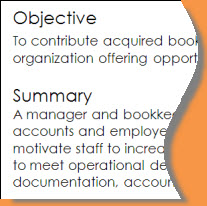
Resume Writing
Objectives, Summaries or Professional Profiles
Introduction

The purpose of a resume is to "sell" your professional expertise to the hiring manger. The summary statement, professional profile, or career objective is the first "advertisement" of your skills and expertise that a hiring manger will see. Each one has a slightly different intent and feel.
In this lesson, you will compare statements and understand their purpose. Then you will determine which one is best for you in order to create one for your own resume.
Should you use a summary statement, profile, or career objective?
In the past, most job seekers included a career objective on their resumes to tell hiring managers what type of position they were looking for. A more recent trend is to include a summary statement or a professional profile in place of the objective. However, some job seekers include both an objective and a summary. Regardless of which you choose to include, this area should:
- Appear just under your contact information
- Be written with a specific job in mind
Why would you choose to include one statement over the another for your resume?
Click on the buttons in the interactive to learn more about introductory statements.
Deciding which approach to take
Consider the following as you decide which approach to take on your own resume.
Should you include or omit a career objective?
Fewer and fewer job seekers are including a career objective on their resumes. The trend to omit the career objective stems from recent research that shows you have a better chance to be interviewed if you write your resume to help an employer fill her open position (which is what she wants), not to tell the employer what you want. However, many job seekers still include it along with a professional summary, especially if they are new to the workforce. Note that whether or not employers expect to see a career objective on your resume is partly dependent on your field. In some fields, like education, job applicants are still expected to include an objective.
Should you use a summary or profile?
The summary and profile statement do essentially the same thing. A summary statement simply restates the key points of your resume, usually in a short paragraph or a few bullet points. A professional profile also highlights the key points from your resume, but it usually focuses more on your accomplishments and accolades.
What should this section do?
Regardless of which you choose to include on your resume, this section should:
- Be focused on helping an employer meet his or her goals (this means you will want to write a slightly different objective or summary statement for each job you are trying to get)
- Start with the most important idea about yourself that you want to tell a hiring manager
- Be brief but concise (a few bullet points of your best skills and achievements, or a sentence or two that really tells a potential employer what you have to offer if he keeps reading)
- Position you as the best model of whatever position, role, or industry you are trying to enter; this means you should research the position before you write your resume for it
- Include keywords—that is, words that every person in the field or position you are trying to get will know; CareerBuilder suggests using some general keywords, too, but these are less critical in a summary statement than in the body of your resume
You try it!

Open your My Resume document to complete this activity. Enter your own information into this document as we progress through each lesson in this unit.
You will be working only in the Objective and Summary portions of the document for this activity. Please refer to the orange box in the following picture:

Replace the template text with your own information. Be sure to remove the brackets as you are replacing text.
- Enter your career goal in the Objective section in place of [Your career goal goes here]. Before you type in your own objective, follow these steps to make sure you write a good one:
- On note paper, jot down:
- The job title you are submitting the resume for (for example, administrative assistant). If you don't know the title, the desired position level (for example, entry-level, part-time, full-time, etc.)
- The field, industry, or area of work (for example, service industry)
- Your areas of specialization or skills (for example, excellent computer, organizational, and interpersonal skills)
- Build your own objective by replacing the (parenthesis) with your answers:
"A (position/level) position using my (skill, skill, and skill) as a (position title) in a (field/industry)."
- On note paper, jot down:
Some resume experts believe including only a simple job title in your objective is better than writing a full statement. For example, these experts would suggest using "A position as a receptionist." rather than "A full-time position using my strong organization, office managment, and customer service skills as a receptionist for an established financial planning firm."
- Modify the Summary section. Do this by replacing the text with either:
- Bullet items that summarize your qualifications, career highlights, and areas of expertise, OR
- A paragraph that answers the same things the template is asking for
You can rename this section with an appropriate title. Some possible titles include Profile, Competencies, Professional Background, Accomplishments, or Areas of Strength.
- Save the file on your computer. You will be adding more information as you progress through the lessons in this unit.